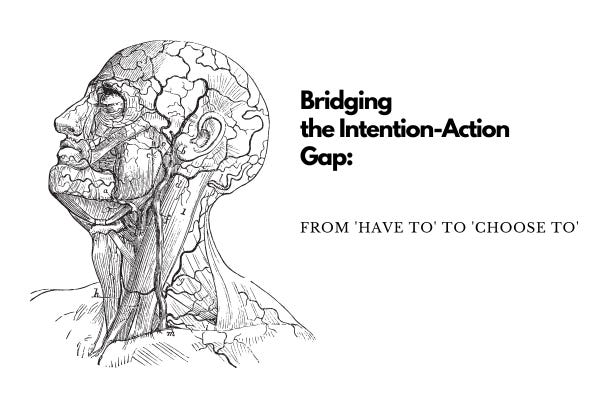From 'Have To; to 'Choose To.' Different Levels of Ownership in Life So That Your Emotions Don't Get in the Way of What Needs to Be Done.
Exercise in free will.
It's no secret that even when we are very motivated to achieve a goal, there is also a bunch of things we're not overly excited about.
The good news is you don't have to like something to do it, and you certainly don't need to feel like doing something to do it.
It sounds trite, but how often your "I can't do it!" is really down to your ability, and how often is it "just" about your emotions?
How you frame it matters.
When you create your to-do list, there might be things you have to do and some that you want to do.
The ‚want to do' category is easy; everything is aligned here, so there's little point in dissecting it further.
But how can you work with the ‘have-to' tasks?
What often helps me overcome my resistance is some catastrophic thinking.
But before we get to it, let's explore the difference in attitude between: have to/get to/ choose to.
The choice of words we use to describe our actions and tasks can have a significant impact on our attitude towards them and our ability to self-lead effectively.
Here are the differences in attitude between "have to," "get to," and "choose to":
"Have to"
It implies that the action or task is a burden or obligation.
Using "have to" can create a negative attitude toward the task, leading to procrastination, low motivation, and a lack of engagement. It can also create a sense of helplessness and victimhood as if we have no control over the situation.
"Get to"
This phrase implies that the action or task is an opportunity or privilege.
Using "get to" can create a positive attitude towards the task, leading to increased motivation, engagement, and a sense of ownership. It can also create a sense of gratitude and appreciation for the opportunity to perform the task.
"Choose to"
“Choosing” implies that we have made a conscious decision to perform the action or task.
Using "choose to" can create a sense of agency and control, leading to increased motivation, engagement, and a sense of purpose. It can also create a sense of ownership and accountability for our actions.
From "have to" to "get to."
I have to do something, but I don't want to.
I have to reply to my annoying client. But would I rather have no clients at all?
I have to move my butt and exercise more to feel better and look better; I just don't feel like it. But at that moment, I picture a friend of mine who is battling cancer and would give a lot to be able to run again.
Yes, it's down to fear - a pretty darn motivating force!
Maybe not the noblest of emotions, but it often gets the job done.
So if you can't get started, picture the negative consequences of not taking action; taste it, smell it, make it real. It can light some fire under your butt.
The freedom of choice.
If you cringe at the idea of whipping the whip, but the carrot is dangling far away on the horizon, there's always the choice to do something.
We do have free will; let's exercise it!
When you choose to do something, you're back in the driver's seat.
This is your reality; this is what needs to happen in order for something else to become even remotely possible; not certain, but possible.
You have a good grasp of your reality, you know what needs to get done, you don't fight reality, you accept it, then you choose to embrace the suck and go to war with a smile on your face.
Bring it on!
Be The Captain of Your Ship.
By reframing our mindset towards tasks as opportunities or choices, we can create a more positive attitude towards them, leading to increased motivation, engagement, and overall success in achieving our desired outcomes.
Using "get to" or "choose to" can be more effective than using "have to."




